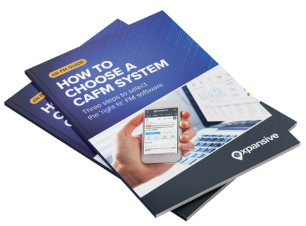Data is the life blood of the modern world. Across every sector it is being used to predict behaviour, inform decision making and optimise our future choices. It is fundamentally changing our world. Except, it seems, in Facilities Management.
Facilities Management is notoriously behind the curve when it comes to data. Most companies aren’t collecting data about their operations, analysing it or using it strategically.
But there’s a good reason for this. 70% of companies don’t have a single digital platform where all the required FM data can be collected and analysed. Even when there is a piece of FM software it may be over complicated, difficult to integrate and not being used by the whole organisation.
The result is:
- Vital FM data is spread out over different systems
- Little integration with other business software e.g. accounting software, BMS etc
- Third party suppliers end up using their own software to record/report hours
- Little or no oversight or control over FM financial data
As a result there’s not much chance of FM and the BODs having a single view of a company’s entire FM operations and assets, or the ability to effectively track and optimise the way we deliver services.
FM software is the answer - but at what cost?
It’s a big challenge to bring together all the data from a fragmented system and start to track, analyse and control the way you work through a single piece of FM software.
FMs often can’t face the expense and disruption of months on end installing a CAFM system. They don’t want the complexity and extra charges involved in setting up and porting data to contractor databases. They don’t want to get involved in configuring complex work order flows and asset registers. They’re not confident in rolling out the contractor portals and help desk software needed to manage operations and keep data flowing in and out of their system. Neither have they got the hardware or budget for expensive IoT initiatives to deliver data in real time.
It doesn’t have to be like this
It sounds obvious, but when you are assessing FM software solutions to bring new control and oversight to your operations you should consider how long it will take, and how straightforward it will be to:
- Get the data into the system
- Maintain the data in the system
- Extract the data from the system
You should look for a partner who can help you mobilise your solution quickly with an intuitive interface that will encourage everyone in your team to use it. Some suppliers will sell you a solution then charge you extra to port data and configure your system, or worse, leave you to figure it out on your own. Then when the solution is actually in place it may take months to train your people to use it and it could lack the reporting suite you really need.
These can be major obstacles to start using the FM software and finally getting access to the data that can drive your strategic decision making.
In assessing any potential supplier you should focus on these data-based priorities:
1.Getting the data in
In the first instance you will need to import considerable amounts of data into your system before you can start using it. This might include:
Details of contractors, rate cards etc
Details of assets - purchase data, warranty documentation, condition reports etc
The system you select should help you with step by step guidance to prepare and upload files so that you don’t omit details and end up with unusable data. Your CAFM vendor should be on hand to help you do this correctly and not use it as an opportunity to charge you for cleansing and uploading files into the system. Many teams find the presence of hidden charges in the setup process can be a big obstacle for completion of a CAFM project, so you should fully understand the charging structures of your partner before you commit.
With some solutions the setup process can just be overwhelming, with the CAFM supplier spending months on data and IoT integrations, before the solution can be rolled out.
But we would argue that you don’t need to do everything at once. You should be able to phase in the introduction of different services so that you can start using software and seeing results quickly.
For example, you might want to sort out your help desk first, move onto PPM, then phase in asset management tools later on depending on your priorities.
2. Maintaining the data
Once you’ve ported the foundational data and configured the system, your organisation will actually need to start using it.
Your system might include helpdesk software, an engineer/contractor portal and asset management tools.
It’s here the usability of the software and the way it captures data will make the difference between a platform that is simply another layer of red tape and a platform that can be used as a strategic tool for your organisation.
What should your work order software look like?
- Easy for clients to quickly report on an issue (supply photos, videos, descriptions)
- It structures data effectively (categorising issues for future reporting)
- It’s automated to ensure orders are dealt with quickly and consistently
- It generates quotes from qualified contractors automatically
- Helpdesk workers can make decisions about where to place work based on quotes and contractor KPIs
What should your engineer/contractor portal look like?
- The engineer/contractor portal is mobile friendly - it can be used easily on the move
- Engineers can find all the details they need about the job through the portal
- Engineers can request further information if they need it via the portal
- Does it help the engineer record their time on site - one button timer stop/start?
- Is it easy for the engineer to record the outcome of the job in the portal?
- Can the contractor invoice via the portal?
If the digital tools for reporting a maintenance problem in a building are accessible and intuitive people will choose to use them rather than phoning or emailing FM.
Being able to properly record time and invoice directly through the portal will incentivise its use by contractors, too, while giving us vital data on spend.
The quality of the tools and the interface you choose will mean that you’re capturing vital data in real time about:
- Condition of assets
- Recurrence of maintenance problems
- Time to fix
- Quality of fixes
- Spend on fixes
The more these tools become central to the everyday working of your organisation from reporting to resolution, the more data you are going to collect and the more useful it will be in driving your decision making.
3. Getting the data out:
All the work you’ve done setting up a CAFM and getting your team to use the tool will pay dividends in the data you will be able to extract at the other end.
These are the reports that will be pivotal to the business in driving FM strategy and giving the BODs the direction they need.
Your chosen system should come with the dashboards that help you visualise and bring this data to life.
Work demand report
Understanding where the demand for FM services is coming from is key to better strategic planning and business problem solving. A work demand report will show you:
- Volume of work requests over time
- Where these requests are coming from
- Spend by category, contractor or site
It will give you the insight to understand if your coverage of staff is adequate, where there are unusual demands on time and resource, where you need to spend effort investigating and problem solving or optimising the way resources are allocated.
Service performance reports
These reports focus on your service KPIs. These indicators may be related to client SLAs - and are therefore pivotal to correct and optimise to meet business targets and avoid fines. They are key to understanding how responsive you are to the needs of the business and the quality of the service you provide.
- Time to Respond
- Time to Attend
- Time to Fix
- First time fixes
- Spend-per supplier
Breaking these reports down by supplier will help you understand which contractors are doing the best job and offering you the best value for money. This is the data that can help you work with suppliers to optimise performance as well as weed out those who are consistently failing to deliver.
Spend report
Tracking and analysing spending is fundamental to reporting on and planning strategy. The right reporting tools can help you better understand and predict required future Capex as well as spotting cost cutting and emerging revenue opportunities.
- Breakdown of work order accruals, committed and approved spend
- Variance vs budget
- Breakdown of spend by Category, Contractor and Site
- Track and predict Capex expenditure
- Graphs to share and visualise financial trends overtime
With these and other dashboards you'll have the insight to drive:
Asset management
- Build and understand the condition of each asset.
- Gain visibility of asset expenditure, performance and work order history.
- Improving The quality of your purchasing with robust asset data
Capex investment:
- Align capital expenditure with unreliable equipment that drives down maintenance costs
- Purchase assets by project or bulk to ensure best costs achieved
- Build long-term asset replacement plans based on condition reports and spend predictions
- Improve warranty management as assets contracts are visible within the CAFM
Conclusion
You can’t make important strategic decisions about your business priorities and opportunities without access to accurate, real time data about the way your equipment and facilities are being used.
You can’t visualise new pressures and opportunities emerging in your part of the business without the data that tracks supplier relationships, asset management, FM activity and spending trends.
You can’t share these insights without the mobile friendly dashboards, graphs and charts that a great CAFM offers.
Data is the priority for more strategic facilities management. A great CAFM should make it easy to collect, maintain and extract the data that will drive our decision making.




